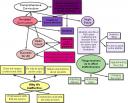Comprehensive and Scripted Curriculum…
Lots of posts flying by about direct instruction. I did one earlier. After some of my discussions with Tom Turner, it seemed like our discussion sometimes bogged down because of a semantic misunderstanding on my part. I think of direct instruction two ways because that is how is starting to be referred to by administrators and teachers where I work. There is Direct Instruction (hey look, that article lacks neutrality–what a surprise!) which is a program of instruction that has some very specific elements. Then there is direct instruction is essentially, the instructional input (teacher talk, lecture) part of a lesson plan (please note there is a request to edit that article). Almost every teacher, including Tom Turner, does some of what would fall under this definition of direct instruction. He is right, I teach a Direct Instruction or scripted curriculum, but I do not teach the whole script.
To write this, I did this organizer to outline my thoughts…

When is a program scripted?
I’ve used two programs that are what I will call comprehensive–almost everything you need to teach the curriculum is (supposed to be) provided.
I’ll use this to illustrate a point about how to tell the difference between a text that is comprehensive, and one that is scripted, and to illustrate problems with scripted programs.
In Teaching in the 408: Reading Education In Year Five TMAO comments:
I read Meier and Darling-Hammond and Banks and Ladson-Billings and there’s this refrain that teachers need more autonomy, that competency-based education is awful, that all forms of standardized assessment have ruined everything for everyone who is not a test-designer. Five years ago I would have ate this up and asked for more, pounded my mental chest and over-utilized phrases like canned curriculum and teacher in a box. Five years ago I think I did do this, was one of the loudest and most persistent member of the I-Hate-High-Point club. Five years later, after closing the reading gap, I’m not buying. I’m still looking, but I’m not ready to pull out the wallet.
While High Point is a comprehensive program, and does provide routines and tips, here was the big difference I noticed between it and Open Court, you were expected to follow the “script” and “routines” in Open Court, in High Point, they were given to you, and you could choose what to use or not use. In addition, it was constructed and written much better for ELLs.
What do I base this assertion on? Well, at my High Point trainings we were asked to talk about different ways we presented lessons and modules. We were told, the teachers’ edition examples are there for you at your choice, you don’t have to use them. If you are not getting results, they suggested you look to see that you did not skip a lesson module (like vocabulary development) as opposed to saying, you didn’t read the script.
With Open Court Training, you’re told to use the routine cards, and they train you in exactly how to deliver the word knowledge (word structure, decoding). We had to listen to our AP tell us at a staff meeting that there was a “problem” in delivery of Clues, Problems, and Wonderings (KWL redo) that is the Set/Into for the weekly selection. It seems teachers (like me) were having the students write it down. This was wrong because it’s an oral exercise for the students, with the teacher recording their ideas.
In contrast, when I did High Point training I told the instructor that for some of the oral comprehension checks. I had my students (at the time mostly low achieving EOs) write these down because I knew they were capable of that, he thought this was fine, and didn’t tell me it was an oral only exercise.
If you don’t believe me, check this out.
What does a scripted program look/sound like?
For those who would like to see a script in action (believe me, you don’t have to torture yourself that way), there is a screencast at the bottom of my sample lesson. It’s about 10 minutes of a screencast and audio doing Word Knowledge and vocabulary in Open Court, which is the most scripted and most directed instruction in the program. Keep in mind, I’m only in my second year teaching Open Court. What I’m finding is the longer I teach it, the more I make it my own delivery, and less theirs. This fits in with what experts have observed when looking at how good teacher teach scripted programs. They use the script, but they don’t it; that’s what makes them successful.
The key elements for me in any program (whether from a publisher or something I create on my own) are these:
1. Is the Set/Into going to both engage them, and activate some prior knowledge? What connections can I help students make before we start the lesson?
2. Is the lesson structured in a way to be accessible to all my students. If I’m handing them a research project, do they know the steps they will need to go through? (some scripted curriculums really bomb at this one).
3. Are the students given an opportunity to actively engage while learning? Are then able to work together constructively? (this is something I have to watch for more from myself)
4. Are the students creating or just recalling? (script and DI is RIFE with this)
All I want is a program not to get in the way of me doing that. I don’t give a damn if they give me a script, as long as they let me change it.




